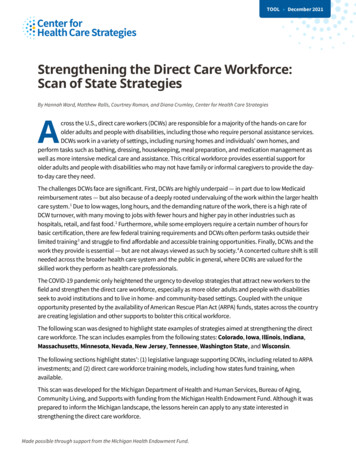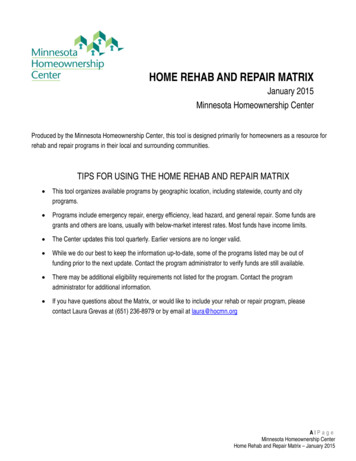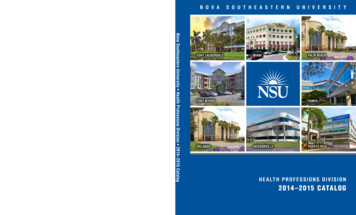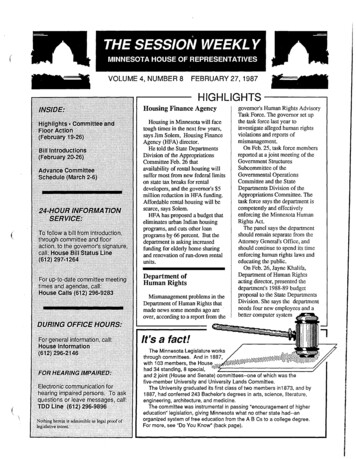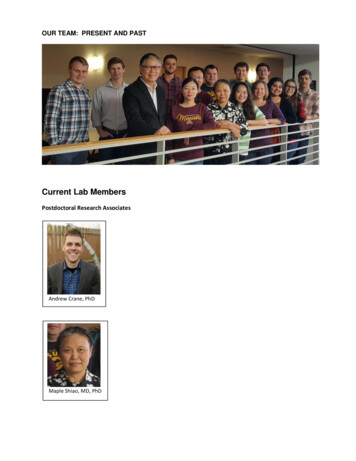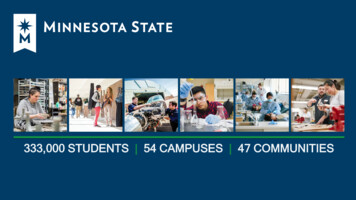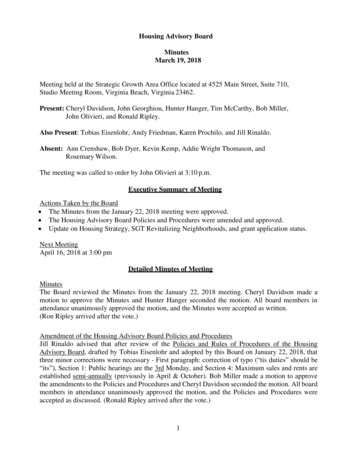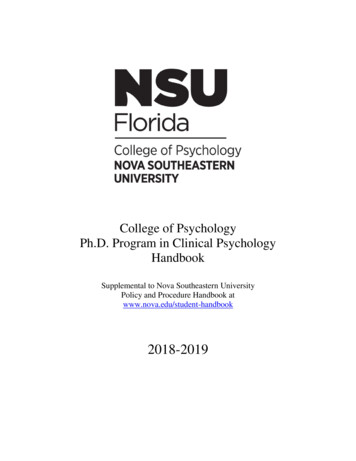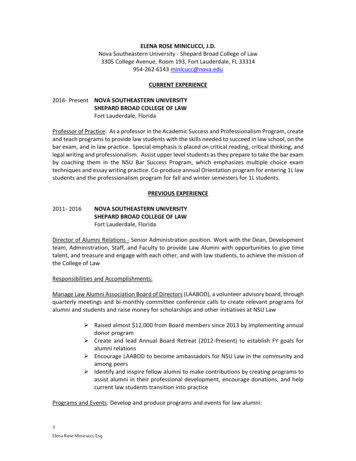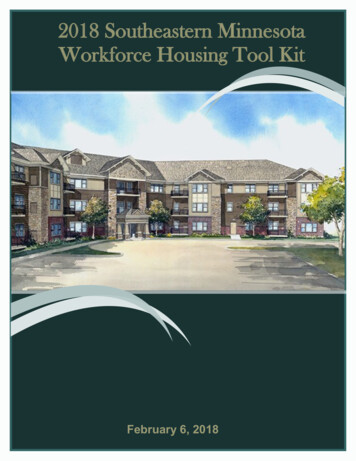
Transcription
2018 Southeastern MinnesotaWorkforce Housing Tool KitFebruary 6, 2018
Executive SummaryThe purpose of the 2018 SE MN Housing Tool Kit is toprovide information, resources, and ideas – “the tools” –necessary to promote and facilitate the workforcehousing needs of Southeast Minnesota.The need for workforce housing, housing that is availablenear local jobs and affordable at local wages—is prominent inSoutheastern Minnesota. The Minnesota Housing FinancingAgency identified in 2014 a number of the following trendsthat remain prevalent throughout Southeast Minnesota today: Economic growth will continue at a modest rate, but willfail to compensate for the much anticipated exponentialgrowth of the housing market. Incomes will likely struggleto keep pace with the expected housing increases. Theresult is a decrease in the affordability of housing for theworkforce. New households are developing as a result of a strongereconomy, increasing the demand for housing. The resultis a decrease in availability of housing for the workforce. Many communities have experienced significant jobgrowth, correlating with the declining unemployment ratesstate wide. To accommodate this growth additional housing is needed. The result is a decrease in the availability ofhousing for the workforce. Rental property vacancy rates are low, indicating a shortage of rental housing. The result is a decrease in theavailability of housing for the workforce.These trends suggest that the workforce is vulnerable toexperience a housing crisis without concerted action fromstakeholders— including the workforce (renters, buyers, andhomeowners), developers, investors, local governments andcommunities. This toolkit provides tools in five core areas:RENTAL TOOLSACQUISITION TOOLSDEVELOPMENT TOOLSREHABILITATION TOOLSCASE STUDIES & ADDITIONAL TOOLS
DEVELOPMENT TOOLSSmall Cities Development Program (SCDP)The Minnesota Department of Economic and EmploymentDevelopment (DEED) created the SCDP to help cities andcounties with funding for housing, public infrastructure, andcommercial rehabilitation projects. Projects must benefit people of low and moderate incomes, eliminate slum and blightconditions—or eliminate an urgent threat to public health orsafety.Workforce Housing Development ProgramFHA/HUD Section 221(d)(4):Construction or SubstantialRehabilitation AmortizingMortgagesFunds may be used for new construction or substantial rehabilitation of multifamily rental housing.Eligible properties include marketrate, low-to-moderate income andsubsidized multifamily properties.Term: Actual construction periodplus 40 years (fully amortizingwith interest only payable duringconstruction period)Interest Rate: Fixed for term ofloan including constructionperiod, determined by marketconditions at time of rate lockAvailability: Applications accepted throughout the yearThis competitive funding program targets small to mid-sizecities in Greater Minnesota with rental workforce housingneeds. Funding is available to build market rate residentialrental properties in communities with proven job growth anddemand for workforce rental housing. Communities are required to secure matching funds, one dollar for every two dollars in funding offered through the program. This program waspreviously administered by the Department of Employmentand Economic Development (DEED) and is now administeredby Minnesota Housing.http://mnhousing.gov/wcs/Satellite?c Page&cid 1503450639018&pagename External%2FPage%Low-Income Housing Tax Credit Program (LIHTC)The Low-Income Housing Tax Credit (HTC) Program is a financing program for qualified residential rental properties.The HTC program offers investors a 10-year reduction in taxliability in exchange for capital to build eligible affordable rental housing units in new construction, rehabilitation, or acquisition with rehabilitation. Applicants must meet the requirements of the LIHTC and the Qualified Allocation Plan (QAP).Term: 15-yr. compliance period and 30-year extended use periodInterest Rate: N/AAvailability for 9% credits: Applications accepted only throughannual RFP’s and Supplemental Round 2Availability for 4% credits: Applications accepted throughoutthe year in conjunction with tax-exempt bondshttp://mnhousing.gov/wcs/Satellite?c Page&cid 1358905254471&pagename External/Page/EXTStandardLayoutPage 2
DEVELOPMENTTOOLSEconomic Development andHousing Challenge Program(MHFA)The purpose of the Economic Development and Housing ChallengeProgram is to provide funding toassist in the development of affordable permanent rental housing.This housing supports economicdevelopment and redevelopmentactivities, job creation, or jobpreservation within a community orregion—by meeting locally identified housing needs.The program serves rental households in Minnesota with incomes ator below 80 percent of state orarea median income.Web Link: Economic Developmentand Housing Challenge (EDHC)ProgramLow and Moderate Income Rental Program (LMIR) andFlexible Financing for Capital Costs (FFCC)The purpose of the Low & Moderate income Rental (LMIR)program is to provide long-term amortizing mortgage debt forMultifamily rental housing affordable to low– and moderateincome Minnesotans. Recipients must qualify under projectselection criteria for multi-unit development mortgage loansfound in the Multifamily RFP Guide. Generally, properties withless than 24 housing units are not financially feasible. FFCC isa deferred loan at low or no interest, available only in partnership with LMIR loans and are used as a mechanism to reducethe overall interest rate of the development.Term: 30-years, fully amortizingInterest Rate: Fixed for the full term of the LMIR loanAvailability: Applications accepted throughout the year andthrough the annual RFP processLow and Moderate Income Rental Program (LMIR) and Flexible Financingfor Capital Costs (FFCC) Program GuideWorkforce and Affordable Homeownership DevelopmentProgramThe Program will provide a one-time grant of up to 375,000for the development of workforce and affordable homeownership projects across Minnesota. The funds will serve households up to 115% area median income (except in the casewhere a project directly benefits a neighborhood or development that includes individuals with a wide range of incomes.)Funds may be used for residential housing development, rehabilitation, land development, infrastructure development andrepair for manufactured home parks. Funds may not be usedto provide down payment assistance or financing for owneroccupied rehabilitation.Workforce and Affordable Homeownership Development ProgramPage 3
REHABILITATION TOOLSSmall Cities Development Program (SCDP)FHA/HUD Section 221(d)(4):Construction or SubstantialRehabilitation AmortizingMortgagesFunds may be used for new construction or substantial rehabilitation of multifamily rental housing.Eligible properties include marketrate, low-to-moderate income andsubsidized multifamily properties.Term: Actual construction periodplus 40 years (fully amortizingwith interest only payable duringconstruction period)Interest Rate: Fixed for term ofloan, including constructionperiod, determined by marketconditions at time of rate lockAvailability: Applications accepted throughout the yearIn addition, need, impact and cost effectiveness must be documented and the general public must be involved in the application process. Cities with fewer than 50,000 residents andcounties with fewer than 200,000 residents are eligible. Thisstate run program rules subdivide grant funds into three general categories:1) Housing Grants– are granted to local units of government,which, in turn, lend funds for the purpose of rehabilitating localhousing stock.2) Public Facility Grants– are granted for wastewater treatment project, including collection systems and treatmentplants; wells, water towers and distribution systems3) Comprehensive Grants– projects frequently include housing and public facility activities described above. In addition,comprehensive projects may include an economic development activity, which consists of loans from the grant recipientto businesses for building, rehabilitation to façade improvements, code violations, and health and safety issues. Themost common economic development activity is rehabilitationof local commercial �Income Housing Tax Credit Program(LIHTC)The purpose of the Minnesota Housing Finance Agency(Minnesota Housing) is to ensure the availability of decent,safe, energy efficient, and affordable housing to low and moderate-income households. In order to achieve its purpose,Minnesota Housing is active in: lending and financing, allocating housing grants and subsidies, advocating for affordablehousing, establishing state housing policies and providingtechnical assistance to housing sponsors.For additional information, please visit the following link:www.mnhousing.gov/get/MHFA 013254Page 4
REHABILITATIONTOOLSRehabilitation Loan/Emergencyand Accessibility Loan Program(MHFA)The Rehabilitation Loan/Emergency and Accessibility LoanPrograms assist low income homeowners in financing basic homeimprovements that directly affectthe safety, habitability, energy efficiency or accessibility of theirhomes.The Emergency and AccessibilityLoan Program is available forhome improvements addressingemergency conditions of the homeor accessibility needs for a disabled household resident. Thisprogram is subject to priorapproval by Minnesota Housing.Additional Loan Program DetailsLow and Moderate Income Rental Program (LMIR) andFlexible Financing for Capital Costs (FFCC)Funds may be used for the refinance, acquisition, rehabilitation or new construction/conversion of rental apartment buildings that house low- and moderate-income Minnesotans. Recipients must qualify under project selection criteria for multiunit development mortgage loans— found in the MultifamilyRFP Guide. Generally, properties with less than 24 housingunits are not financially feasible. FFCC is a deferred loan atlow or zero interest, available only in conjunction with LMIRfirst mortgage loans.Term: 30-years, fully amortizingInterest Rate: Fixed for the full term of the LMIR loanAvailability: Applications accepted throughout the yearand through the annual RFP processLow and Moderate Income Rental Program (LMIR) and Flexible Financingfor Capital Costs (FFCC) Program GuideWorkforce and Affordable Homeownership DevelopmentProgramThe funds may be used for residential housing developmentand rehabilitation, land development, and infrastructure development and repair for manufactured home parks. Criteria Review is as follows: 1) the extent to which the proposal is aninnovative workforce housing project 2) it identifies a compelling local community need 3) extent to which the proposal addresses the needs of underserved populations 4) amount ofnon-state resources and financing committed 5) type of proposed activity is not typically funded under the Single FamilyRFP.Workforce and Affordable Homeownership Development ProgramPage 5
REHABILITATIONTOOLSPublicly Owned Housing Program (POHP)Funds may be used for rehabilitation of public housing developments owned by a local unit ofgovernment, particularly to address health, safety and conservation issues of a capital nature.Term: 20 yearsInterest Rate: Zero interest deferred loan forgiven after 20years, if no event of default.Applicant is required to continueto own and operate the development for a public purpose untilthe property is sold.Availability: Applications accepted through a stand-alone RFPprocessAdditional POHP DetailsRehabilitation Loan Program offered through (MHFA)This program created by the Minnesota Housing Finance Agency(MHFA), is solely for the rehabilitation of existing rental properties.New construction and acquisition are not eligible under this program.Private individuals, corporations, partnerships, non-profit organizations, and Community Housing Development Organizations are eligible to apply for these funds. Non-federally subsidized, existing rentalproperty with any number of housing units are eligible for funding.Term: 10-15 yearsInterest Rate: Generally 0 percent unless a higher rate is necessaryto allow the funding source to be used with other sources, such hashousing tax creditsRequirements: Principal place of residence for past 6 months, current with mortgage payments/property taxes, have homeownersinsurance, have less than 25,000 in assets, and must have homeweatherized by either SEMCAC or Three River Community Action.MNHA Rehabilitation Loan ProgramPreservation Affordable Rental Investment Fund (PARIF)Minnesota Housing designed this program to provide funding to support the preservation of federally assisted, permanent rental housingwhere federal subsidies are at risk of being lost. It is also used for thepreservation of existing supportive housing properties. Funds can beused for acquisition, rehabilitation or debt restructuring. For federallyassisted properties, funds may also be used for equity take-out loans.Term: Deferred up to 30 yearsInterest Rate: 0% unless other funds—such as tax credits, require aninterest rateAvailability: Applications accepted throughout the year and during theannual RFP processPreservation Affordable Rental Investment Fund (PARIF) ProgramPage 6
REHABILITATIONTOOLSEconomic Development andHousing Challenge Program(EDHC)Funds may be used for construction, acquisition, and rehabilitationof permanent rental housing thatsupports economic developmentand redevelopment activities, jobcreation, or job preservation withina community or region by meetinglocally identified housing needs.Deferred LoansMinnesota Housing offers deferred loans for developmentsthat qualify under the preservation, supportive and workforcehousing Strategic Priority Policy Thresholds. Deferred fundsare generally structured as repayable loans at 0% for a termof 30 years.Term: Typically 30 yearsInterest Rate: Generally 0 percent unless a higher rate is necessary to allow the fundingsource to be used with othersources, such as housing taxcreditsAvailability: Applications accepted through the annual RFP processAdditional EDHC DetailsTo apply, applicants must fill out the Deferred Priority ChecklistRental Rehabilitation Deferred Loan Pilot Program (RRDL)Funds may be used for moderate rehabilitation of existingsmall or midsize rental housing in Greater Minnesota. Thegoal is to preserve affordability and provide low- and moderate-income households with access to decent housing that isconvenient to jobs, transportation and essential services.Term: 10-30 years, depending on loan amountInterest Rate: 0%Availability: Applications accepted in one of three ways: Contact the closest administrator to apply for funding.Refer to the RRDL webpage for a list of participating administrators. During an open RFP process, submit a Program Modelapplication to become a program administrator. Submit a Specific Project application directly to MinnesotaHousing for a project located outside an administrator’sarea, a project needing rehabilitation beyond the administrator’s qualifications, or a project owned by anadministrator.Page 7
ACQUISITION TOOLSHOME Investment Partnerships (HOME) ProgramThe HOME Investment Partnerships Program provides formula grants to states and localities that communities use– oftenin partnership with local nonprofit groups– to fund a widerange of activities including building, buying, and/or rehabilitating affordable housing for rent or homeownership or providingdirect assistance to low-income people. HOME is the largestFederal block grant to state and local governments designedexclusively to create affordable housing for low-incomehouseholds.Economic Development andHousing Challenge Program(EDHC)Funds may be used for construction, acquisition, and rehabilitationof permanent rental housing thatsupports economic developmentand redevelopment activities, jobcreation, or job preservation withina community or region by meetinglocally identified housing needs.Term: Typically 30 yearsInterest Rate: Generally 0 percent unless a higher rate is necessary to allow the fundingsource to be used with othersources, such as housing taxcreditsAvailability: Applications accepted through the annual RFP processTerm: 30 yearsInterest Rate: 0 percent unless other funds, such as taxcredits, require an interest rateAvailability: Applications accepted throughout the year andduring the annual RFP processHOME Rental Rehabilitation ProgramPreservation Affordable Rental Investment Fund(PARIF)Funds may be used to preserve at risk project based federallysubsidized developments or existing supportive housing developments. Funds may be used for acquisition, rehabilitationand debt restructuring. Funds may also be used for limited equity takeout in conjunction with a high priority federally subsidized preservation effort.Term: Deferred up to 30 yearsInterest Rate: 0 percent unless other funds, such as tax credits, require an interest rateAvailability: Applications accepted throughout the year andduring the annual RFP processPreservation Affordable Rental Investment Fund (PARIF) ProgramPage 8
ACQUISITIONTOOLSLow and Moderate Income Rental Program (LMIR) and FlexibleFinancing for Capital Costs(FFCC)Funds may be used for the refinance, acquisition, rehabilitationor new construction/conversion ofrental apartment buildings thathouse low- and moderate-incomeMinnesotans.Recipients must qualify under project selection criteria for multi-unitdevelopment mortgage loansfound in the Multifamily RFPGuide.Generally, properties with lessthan 24 housing units are not financially feasible. FFCC is a deferred loan at low or no interest,available only in conjunction withLMIR first mortgage loans.Term: 30-years, fully amortizingInterest Rate: Fixed for the fullterm of the LMIR loanAvailability: Applications accepted throughout the year andthrough the annual RFP processAdditional Program DetailsFHA/HUD Section 223 (f): Acquisition and RefinancingAmortizing LoansFunds may be used for acquisition, refinance or moderate rehabilitation of multifamily rental housing. Eligible propertiesinclude existing multifamily rental apartments with at least fiverental units; market rate, moderate income or subsidizedrents. Project must be constructed or substantially rehabilitated more than three years prior to date of application for mortgage insurance.Term: Maximum of 35 years, fully amortizingInterest Rate: Fixed for term of loan, determined by marketconditions at time of rate lockAvailability: Applications accepted throughout the yearAdditional Loan DetailsEnhanced Financial Capacity Homeownership InitiativeThe Enhanced Financial Capacity Homeownership Initiative(Homeownership Capacity) is a pilot initiative targeted to lowincome renters and emerging market households (i.e., households of color or Hispanic ethnicity) to increase their probability of successful homeownership in Minnesota. The servicesavailable under Homeownership Capacity will be providedthrough collaborative efforts with organizations that workclosely with and/or provide outreach to low-income rentersand emerging market populations. Homeownership Capacitysupplements the traditional homeowner training provided bythe Homeownership Advisors Network, coordinated by theMinnesota Homeownership Center. As part of this effort, Minnesota Housing will work with designated organizations to increase the probability of successful homeownership andhousehold stability through intensive financial empowermentand homeowner training.Additional Initiative DetailsPage 9
REFINANCING DETAILSDeferred LoansMinnesota Housing offers deferred loans for developmentsthat qualify under the preservation, supportive, and workforcehousing Strategic Priority Policy Thresholds. Deferred fundsare generally structured as repayable loans at 0% for a termof 30 years.To apply for deferred funds applicants must fill out the Deferred Priority ChecklistFHA/ HUD Section 223 (f): Acquisition and RefinancingAmortizing LoansPreservation Affordable RentalInvestment Fund (PARIF)Funds may be used to preserve atrisk project based federally subsidized developments or existingsupportive housing developments.Funds may be used for acquisition,rehabilitation and debt restructuring.Funds may also be used for limitedequity takeout in conjunction with ahigh priority federally subsidizedpreservation effort.Term: Deferred up to 30 yearsInterest Rate: 0 percent unlessother funds, such as tax credits,require an interest rateAvailability: Applications acceptedthroughout the year and during theannual RFP processPreservation Affordable Rental Investment Fund (PARIF) ProgramFunds may be used for acquisition, refinance or moderate rehabilitation of multifamily rental housing. Eligible propertiesinclude existing multifamily rental apartments with at least fiverental units; market rate, moderate income or subsidizedrents. Project must be constructed or substantially rehabilitated more than three years prior to date of application for mortgage insurance.Term: Maximum of 35 years, fully amortizingInterest Rate: Fixed for term of loan, determined by marketconditions at time of rate lockAvailability: Applications accepted throughout the yearHUD Risk Share Streamlined RefinanceFunds may be used to refinance existing HUD Risk Shareloans for affordable multifamily housing. Funds are for firstmortgage fixed-rate amortizing debt for multifamily rentalhousing affordable to low- and moderate-income households.Properties must have an existing HUD Risk Share loanthrough Minnesota Housing.Term: Up to 12 years beyond remaining term of existing RiskShare mortgage; not to exceed the original term of the originalloan; not to exceed 75 percent remaining economic lifeInterest Rate: Will be published for each calendar quarter. Uponreceipt of a signed loan application, interest rate will be held forsix months to allow for loan closing. Final interest rate will be fixedfor full term of the loan.Availability: Applications accepted throughout the yearPage 10
CASE STUDY TOOLSProperty Tax Abatement: Austin, MNWedgewood Cove Townhomes:Albert Lea, MNA Partnership and Collaborationbetween the City of Albert Lea,Freeborn County, and the AlbertLea Schools resulted in 85% property tax abatement for 10 years on24 market rate rental units, whichmet local housing study needs.The Developer, Wedgewood CoveTownhomes, LLC., also utilized existing infrastructure and negotiatedwith the existing vacant lot ownersto develop the housing.Contact: Albert Lea City Manager’sOffice, 507-377-4330 orcadams@ci.albertlea.mn.usTools/Strategies Used: Housing Study completion thatillustrated a need for marketrate rental housing units in thecommunity Pro Forma & Cash Flow Analysis completion by the developerto confirm gap in project funding and need for additional assistance Property Tax AbatementThe City of Austin, Mower County, and School District #492partnered to create a five-year property tax abatement for newconstruction single-family and multi-family homes. The abatement occurs on any valuation increase during the five years ofthe new construction. The program is available from August 1,2016—December 31, 2019.Resource: Minnesota Statute 469.1813 Subdivision 8 placeslimitations on tax abatement.Contact: HRA Austin, 507/433-1866, austinhra.orgNobles Home Initiative: Worthington, MNThe purpose of Nobles Home Initiative is to provide incentivesto encourage the construction of new owner occupied andrental residential housing units within the City of Worthingtonbetween April 1, 2014 and December 31, 2017. The City ofWorthington utilized property tax abatement as a tool to createmore new owner occupied residential units.Tax Credits: Owatonna, MNMetro Plains produced three developments in Owatonna thatwere tax credit projects and have been well received in thecommunity for workforce housing: Cedar Run Townhomes,Willow Run Townhomes, Willow Run II Townhomes.Resource: Low-Income Housing Tax Credits (LIHTC)WREDC-JBS Rental Housing Challenge Fund: Worthington, MNJBS, a private corporation, and Worthington Regional Economic Development Corporation came together to create aseparate entity to create workforce housing. The purpose ofthe Rental Housing Challenge Fund is to promote and allowfor the construction of new market rate rental housing developments within Nobles County.Page 11
CASE STUDY & ADDITIONAL TOOLSADDITIONAL TOOLS AND RESOURCES Local Housing Redevelopment Authority (HRA) Water’s Edge—St. John’s Lutheran Home Campus: AlbertLea, MN Area Foundations (examples) The City of Albert Lea partneredwith St. John’s Lutheran Home toconstruct independent, assistedliving, and future duplex townhomes that will be either owneroccupied or rentals to meet thegrowing demand in senior housingin the community. Greater Minnesota Housing Fund651-221-1997, info@gmhf.com Community Land Trusts (examples) Cities occasionally negotiate the cost-share of publicinfrastructure including the utilization of special assessments to defer the costs of public infrastructure to a development over time.Federal Deposit Insurance Corporation Cities occasionally negotiate partial or full reduction offees if practical for the city, developer and community.Examples include building permit fees, land-use fees,financial analysis fees (i.e. TIF application or tax abatement), park dedication fees, water and sewer connection fees, etc.Public Infrastructure Cost-share or deferral Minnesota Community Land Trust CoalitionMunicipal Fee WaiversContact: Albert Lea City Manager’sOffice, 507-377-4330 orcadams@ci.albertlea.mn.usTools/Strategies Used: Housing Study completion thatillustrated a need for seniorhousing units in the community Pro Forma & Cash Flow Analysis completion by the developerto confirm gap in project funding and need for additional assistance Tax Increment Financing Developer use of U.S. Department of Agriculture (USDA)loans Municipal Private Activity BondsRochester Area FoundationSteve Borchardt, Housing Initiative Director, 507-4242415, steve.borchardt@rochesterarea.org The primary tool used for the development was tax increment financing, in compliance with StateLaw for housing development.Example: Housing Revenue Bonds may be used forspecified housing projects as allowed by State LawKay Gregg, Community Affairs Specialist, 763-5310440 ext. 4930, DGregg@FDIC.govSoutheast Minnesota Realtors Association 507-285-9833, info@semnrealtors.comPage 11
CASE STUDY & ADDITIONAL TOOLSADDITIONAL TOOLS AND RESOURCES New Market Tax Credits (NMTC) ProgramThe NMTC Program attracts private capital into lowincome communities by permitting individual and corporateinvestors to receive a tax credit against their federal income tax in exchange for making equity investments inspecialized financial intermediaries called Community Development Entities (CDEs). The credit totals 39% of theoriginal investment amount and is claimed over a period ofseven years.Historically, low-income communities experience a lack ofinvestment, as evidenced by vacant commercial properties, outdated manufacturing facilities, and inadequate access to education and healthcare service providers. TheNew Market Tax Credit Program (NMTC Program) aims tobreak this cycle of disinvestment by attracting the privateinvestment necessary to reinvigorate struggling local economies.As it pertains to housing, an example of a Qualified LowIncome Community Investments (QLICIs) is a businessthat develops or rehabilitates for-sale housing units locatedin a Low-Income Community (LIC).For more information, please see the attached NMTC Program Fact Sheet in Addendum A or the U.S. Departmentof the Treasury Community Development Financial Institutions Fund.Page 11
weatherized by either SEMCAC or Three River Community Action. MNHA Rehabilitation Loan Program Preservation Affordable Rental Investment Fund (PARIF) Minnesota Housing designed this program to provide funding to sup-port the preservation of federally assisted, permanent rental housing where federal subsidies are at risk of being lost.

